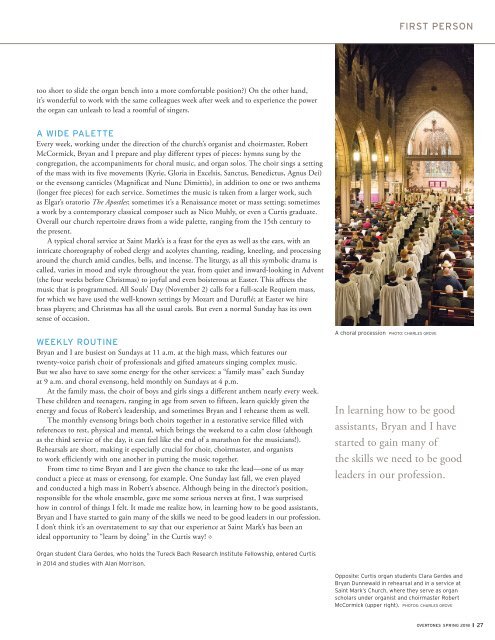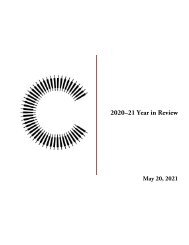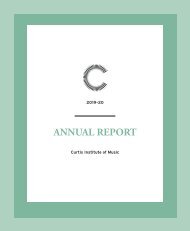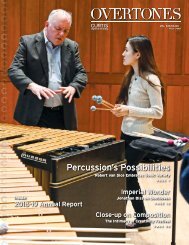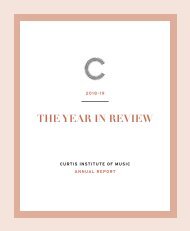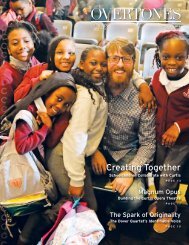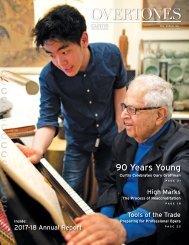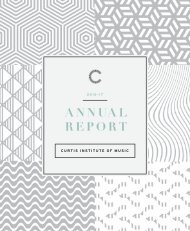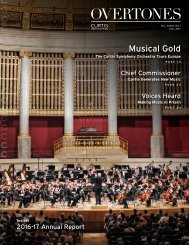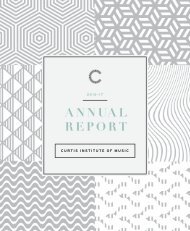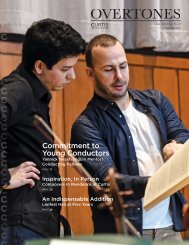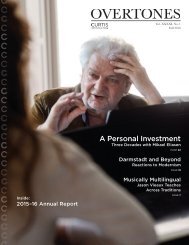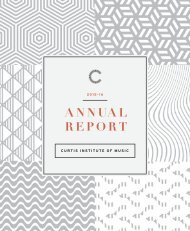You also want an ePaper? Increase the reach of your titles
YUMPU automatically turns print PDFs into web optimized ePapers that Google loves.
FIRST PERSON<br />
too short to slide the organ bench into a more comfortable position?) On the other hand,<br />
it’s wonderful to work with the same colleagues week after week and to experience the power<br />
the organ can unleash to lead a roomful of singers.<br />
A WIDE PALETTE<br />
Every week, working under the direction of the church’s organist and choirmaster, Robert<br />
McCormick, Bryan and I prepare and play different types of pieces: hymns sung by the<br />
congregation, the accompaniments for choral music, and organ solos. The choir sings a setting<br />
of the mass with its five movements (Kyrie, Gloria in Excelsis, Sanctus, Benedictus, Agnus Dei)<br />
or the evensong canticles (Magnificat and Nunc Dimittis), in addition to one or two anthems<br />
(longer free pieces) for each service. Sometimes the music is taken from a larger work, such<br />
as Elgar’s oratorio The Apostles; sometimes it’s a Renaissance motet or mass setting; sometimes<br />
a work by a contemporary classical composer such as Nico Muhly, or even a Curtis graduate.<br />
Overall our church repertoire draws from a wide palette, ranging from the 15th century to<br />
the present.<br />
A typical choral service at Saint Mark’s is a feast for the eyes as well as the ears, with an<br />
intricate choreography of robed clergy and acolytes chanting, reading, kneeling, and processing<br />
around the church amid candles, bells, and incense. The liturgy, as all this symbolic drama is<br />
called, varies in mood and style throughout the year, from quiet and inward-looking in Advent<br />
(the four weeks before Christmas) to joyful and even boisterous at Easter. This affects the<br />
music that is programmed. All Souls’ Day (November 2) calls for a full-scale Requiem mass,<br />
for which we have used the well-known settings by Mozart and Duruflé; at Easter we hire<br />
brass players; and Christmas has all the usual carols. But even a normal Sunday has its own<br />
sense of occasion.<br />
WEEKLY ROUTINE<br />
Bryan and I are busiest on Sundays at 11 a.m. at the high mass, which features our<br />
twenty-voice parish choir of professionals and gifted amateurs singing complex music.<br />
But we also have to save some energy for the other services: a “family mass” each Sunday<br />
at 9 a.m. and choral evensong, held monthly on Sundays at 4 p.m.<br />
At the family mass, the choir of boys and girls sings a different anthem nearly every week.<br />
These children and teenagers, ranging in age from seven to fifteen, learn quickly given the<br />
energy and focus of Robert’s leadership, and sometimes Bryan and I rehearse them as well.<br />
The monthly evensong brings both choirs together in a restorative service filled with<br />
references to rest, physical and mental, which brings the weekend to a calm close (although<br />
as the third service of the day, it can feel like the end of a marathon for the musicians!).<br />
Rehearsals are short, making it especially crucial for choir, choirmaster, and organists<br />
to work efficiently with one another in putting the music together.<br />
From time to time Bryan and I are given the chance to take the lead—one of us may<br />
conduct a piece at mass or evensong, for example. One Sunday last fall, we even played<br />
and conducted a high mass in Robert’s absence. Although being in the director’s position,<br />
responsible for the whole ensemble, gave me some serious nerves at first, I was surprised<br />
how in control of things I felt. It made me realize how, in learning how to be good assistants,<br />
Bryan and I have started to gain many of the skills we need to be good leaders in our profession.<br />
I don’t think it’s an overstatement to say that our experience at Saint Mark’s has been an<br />
ideal opportunity to “learn by doing” in the Curtis way! <br />
A choral procession PHOTO: CHARLES GROVE<br />
In learning how to be good<br />
assistants, Bryan and I have<br />
started to gain many of<br />
the skills we need to be good<br />
leaders in our profession.<br />
Organ student Clara Gerdes, who holds the Tureck Bach Research Institute Fellowship, entered Curtis<br />
in 2014 and studies with Alan Morrison.<br />
Opposite: Curtis organ students Clara Gerdes and<br />
Bryan Dunnewald in rehearsal and in a service at<br />
Saint Mark’s Church, where they serve as organ<br />
scholars under organist and choirmaster Robert<br />
McCormick (upper right). PHOTOS: CHARLES GROVE<br />
OVERTONES SPRING <strong>2018</strong><br />
27


